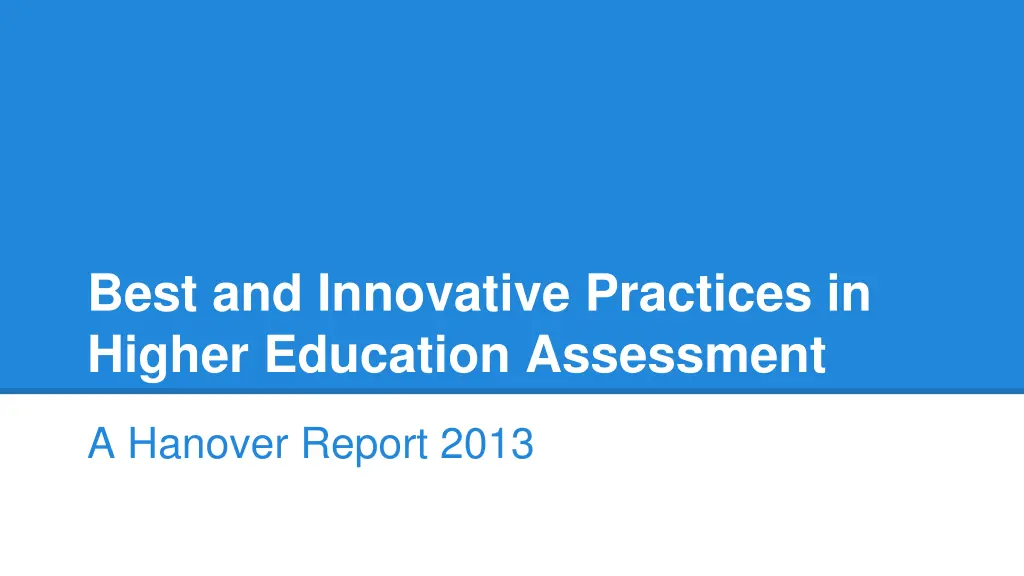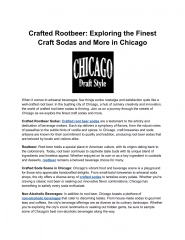
Innovative Practices in Higher Education Assessment: Trends & Future Directions
Explore the latest trends in higher education assessment and accreditation, delving into innovative practices and future directions. Discover how institutions are adapting to meet student needs and government regulations while emphasizing quality and access in global education.
Download Presentation

Please find below an Image/Link to download the presentation.
The content on the website is provided AS IS for your information and personal use only. It may not be sold, licensed, or shared on other websites without obtaining consent from the author. If you encounter any issues during the download, it is possible that the publisher has removed the file from their server.
You are allowed to download the files provided on this website for personal or commercial use, subject to the condition that they are used lawfully. All files are the property of their respective owners.
The content on the website is provided AS IS for your information and personal use only. It may not be sold, licensed, or shared on other websites without obtaining consent from the author.
E N D
Presentation Transcript
Best and Innovative Practices in Higher Education Assessment A Hanover Report 2013
Hanover Research In the following report, Hanover Research investigates innovative practices in higher education assessment. Trends and future directions in assessment and accreditation are also discussed.
Literature Review A review available literature on trends and future directions of assessment and accreditation
Trends Provide students with the appropriate information to make enrollment decisions including language that stresses accountability and transparency. The direction taken by accreditation in the coming years is toward more government involvement and standardization across measures of quality. Some regional accrediting agencies are preparing for this by providing more structure and guidance to institutions while still allowing for flexibility and innovation. The future of global higher education accreditation places more emphasis on access and equity, though quality is also a predominant feature.
Trends Faculty that use innovative assessment practices take care to be explicit in communicating learning outcomes and expectations to students, and are deliberate in aligning learning outcomes with valid assessment tools. A common practice among best practice institutions is to use portfolios and other physical or digital compilations of student achievements to assess learning outcomes. This type of assessment is well poised to make use of emerging technologies such as badges and e-portfolios. Qualitative reviews such as mentor meetings, committee reviews, and self assessments are also common among the institutions reviewed in this report. These are particularly relevant when evaluating non-technical student learning outcomes that are not easily measured by more traditional assessments.
TRENDS AND FUTURE DIRECTIONS Reviewed literature on trends and future directions of assessment and accreditation in higher education. Primarily focuses on the United States.
TRENDS AND FUTURE DIRECTIONS The goal of this section is to identify potential issues related to the future direction of accreditation and assessment in order to assist institutions with formulating goals for Campus- Wide Assessment Plans.
BACKGROUND CHEA President Judith Eaton, policy related to accreditation and assessment is being transformed by a variety of factors 1. the federal money at stake 2. the price of higher education 3. the expectation of universal access 4. the press for greater public accountability 5. the nationalizing of public policy 6. the immediacy created by electronic technology
Factors Driving Discussions around the Future of Accreditation and Assessment Emphasis on accountability and public demands for evidence of student achievement from colleges and universities.
Emerging issues impacting higher education accreditation From: CHEA International Quality Group Higher education and quality assurance and relationships with government Innovations and what some call disruptive technologies such as massive open online courses (MOOCs) and open badges , including the for-profit sector
Emerging issues impacting higher education accreditation cont. Crossborder higher education in its different forms Regional harmonization of quality assurance as a new development Rankings and quality assurance Links between qualifications frameworks and quality assurance Diversity of private providers
FUTURE DIRECTIONS FOR ACCREDITATION AND ASSESSMENT Our review of literature relating to the future of higher education accreditation revealed that in the coming years, there is likely to be an increased involvement of the federal government, and, as a result, more regulation of the accreditation process.
2013 State of the Union supplement The President will call on Congress to consider value, affordability, and student outcomes in making determinations about which colleges and universities receive access to federal student aid, either by incorporating measures of value and affordability into the existing accreditation system; or by establishing a new, alternative system of accreditation that would provide pathways for higher education models and colleges to receive federal student aid based on performance and results.
National Advisory Committee on Institutional Quality and Integrity (NACIQI) Final 2012 draft report of recommendations for Higher Education Accreditation Reauthorization highlights three key features that describe how accreditation will be viewed and how the federal government would like it to operate in the future.
NACIQI Report 2012 cont. It envisions a future role of accreditation as primarily focused on public accountability and consumer protection, with less emphasis on quality improvement. Call for change in the government role: this feature significantly expands the role of the federal government in judging academic quality as well as establishing standards for quality. Government would determine what is important.
NACIQI Report 2012 cont. Report calls for judgment of academic quality to be increasingly based on common definitions and common data, the report encourages a convergence of accreditation standards. This is a significant challenge to the decentralized structure of accreditation as well as the diverse, mission-driven enterprise of higher education itself.
Secretary of Educations Commission on the Future of Higher Education. 2006 issue paper Describes several recommendations for developing a national blueprint for transforming accreditation . a national accreditation framework must be developed, one that holds higher education accountable for results. Accrediting processes and decisions should strongly emphasize performance outcomes and student-learning outcomes in particular.
Secretary of Educations Commission on the Future of Higher Education. 2006 issue paper cont. This proposed National Accreditation Framework includes three components: 1. Performance Outcome Measures. The strongest emphasis would be placed on the demonstration by institutions and programs that they are producing results, especially evidence of student learning.
Secretary of Educations Commission on the Future of Higher Education. 2006 issue paper cont. 2. New Process Standards. The framework would promote more open and flexible process standards that encourage innovation and diversity in higher education and do not prescribe specific input and process standards (e.g., facilities, faculty). They are flexible because they promote creative solutions that are continuously being changed and adapted and are effective in getting results and promoting continuous improvement.
Secretary of Educations Commission on the Future of Higher Education. 2006 issue paper cont. 3. Continuous Improvement. The framework would require institutions and programs to move toward world-class quality and report measurable progress in relationship to their national and international peers. This requirement would be modeled using leading best practices for benchmarking and continuous improvement techniques.
Secretary of Educations Commission on the Future of Higher Education. 2006 issue paper cont. The second recommendation is to set expectations and build capacity for measuring student learning. The Commission is in favor of developing national standards for how institutions and programs define and assess their own student learning performance.
Secretary of Education Comm Cont. Such national standards would address the following: Defining student learning outcomes. These standards should require institutions and programs to define their learning outcomes based on their own missions and the input of the employers and other stakeholders. However, these standards should require institutions and programs to use a common format so that similarities and differences are transparent to students, parents, and employers.
Secretary of Education Comm cont. Valid and reliable assessments. These standards also should establish some requirements for valid and reliable assessments so that accrediting organizations can provide the public some assurance that students receiving degrees or other types of credentials have the skills that institutions and programs claim. 10
New Leadership Alliance 2012 Brief A 2012 brief from the New Leadership Alliance on the future of institutional accountability and assessment provides several guidelines to help institutions take responsibility for assessing and improving student learning. The guidelines below outline actions to be taken to systematically gather evidence of student learning:
New Leadership Alliance 2012 Brief Policies and procedures are in place that describe when, how, and how frequently learning outcomes will be assessed. Assessment processes are ongoing, sustainable, and integrated into the work of faculty, administrators, and staff. Evidence includes results that can be assessed against an externally informed or benchmarked level of achievement or compared with those of other institutions and programs.
New Leadership Alliance 2012 Brief Evidence also includes assessments of levels of engagement in academically challenging work and active learning practices. Results can be used to examine differences in performance among significant subgroups of students, such as minority, first-generation, and non-traditional-age students.
Trends Among Accrediting Organizations Nearly all regional accreditors have standards that include the expectation that institutions clearly state learning outcomes. Additionally, all regional accreditors expect institutions to assess stated learning outcomes at all levels with multiple measures, both direct and indirect, and these measures must be appropriate for what is being assessed.
Trends Among Accrediting Organizations Regional accreditation organizations take care not to prescribe specific methods or tools for assessing outcomes. In fact, each [accrediting body] stressed the diversity of institutions in its region and the need for the assessment process to reflect the concerns of the institution.
Trends Among Accrediting Organizations All of the accreditors echoed the sentiment that institutions should select the process that works best for them while at the same time institutions should draw on multiple indirect and direct measures for evidence of student learning. All regional accreditors agreed that institutions should embed the assessment process in activities already taking place on campus.
Trends Among Accrediting Organizations While not prescribing a model, regional accreditors expect that a campus s assessment activities will be supported by an institutional commitment to the assessment by the institution s president and other leaders and through funding and other support for assessment activities.






















